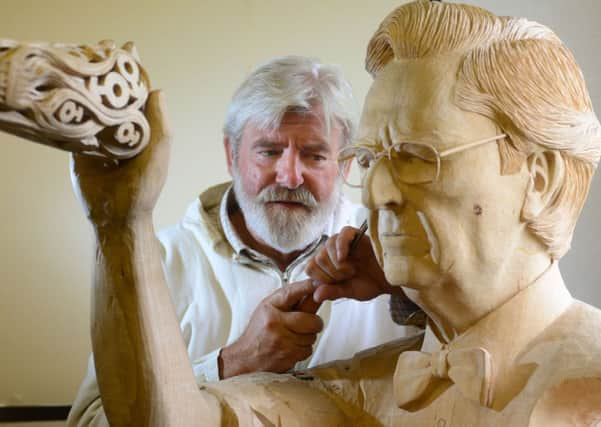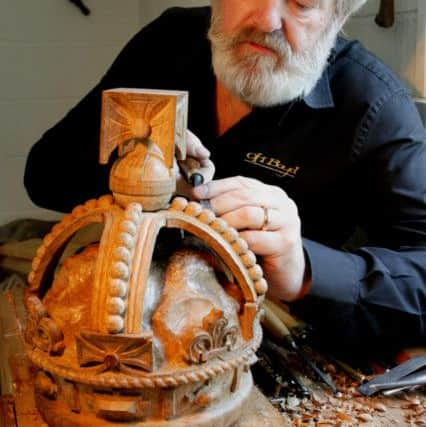Historic heart of oak


Only a faint tang of ozone and a salty sheen give a clue to its origins. If anything it looks too new for a piece of 700-year-old wood which was once part of Lord Nelson’s legendary flagship HMS Victory and now has been used to make the Imperial crown which sits on top of the new State Coach.
“It was the tough interior – the heart of oak – they used to build these ships. Hard enough to stop cannon balls. As the song goes: ‘Heart of oak are our ships, jolly tars are our men,” says OH Boyd, sitting in his workshop by Barton Haven, in north Lincolnshire, as we examine the small chunk of light-coloured offcut.
Advertisement
Hide AdAdvertisement
Hide Ad“It grew for 300 years and its keel was laid in the 1690s. The day the contract was signed to build HMS Victory, Nelson was born.”


The wood was “without doubt” at the Battle of the Nile (1798) and the Battle of Trafalgar (1805) – one of the most decisive battles in English history – and it should now last another 200 years on the coach as successive monarchs ride in her. “When I carved it, I thought this is the biggest achievement of my life,” says Boyd. A lover of history he helped out with the research for the coach which was assembled by coachbuilder Jim Frecklington in his workshop in Sydney, Australia. The Queen travelled in the gold and black coach for its first outing to the State Opening of Parliament in June.
Boyd, was watching from the Palace yard as it travelled down the Mall, lost amidst the trotting ranks of the Household Cavalry, with just the Crown visible. “That was very symbolic, “ says Boyd, “because the Crown is overall.”
The coach is very “bling”, gold wheels and all, I suggest and he replies: “There’s more gold in it than any other coach apart from the Coronation coach. Others look dowdy by comparison.”
Advertisement
Hide AdAdvertisement
Hide AdA living time capsule, the handrails were made from Royal Yacht Britannia timber and historical pieces of wood – one contains timber from the 3,800-year-old North Ferriby log boat which Boyd helped source – were varnished and inlaid in the interior wall and door panels. What look like little crowns in the corner of the panels in the Coach are in fact gear teeth from a John Harrison clock, about which, more later.
The Crown, the centrepiece of the roof’s decorations, was covered in gold leaf. Nothing suggests the horrors the ship had seen in its history. “(In battle) the scuppers ran with blood, you can’t imagine how horrific it would be with the guns going off, no air. You are in the Mediterranean, hot, 821 men crammed into the little ship, a nightmare really,” says Boyd.
Nor would anyone guess that the interior of the Crown is hollow, making room for a camera, giving Her Majesty – and Her security staff – 360 degree views of the crowd.
Boyd has been whittling wood since he was little boy. He remembers pinching his Dad’s penknife and using it to carve a tiny set of steps.
Advertisement
Hide AdAdvertisement
Hide Ad“I’ve whittled ever since, I do a lot of detailed work with a penknife. It surprises folks,” he adds.
He trained as an engineer with Rolls Royce and worked for them as a draughtsman, but got fed up with being away from home so much and opened a workshop making furniture. Then tragedy struck – his apprentice “a wonderful lad of 19” was killed in a car crash just as Boyd had written up deeds of partnership.
Then his own son, also 19, was also killed in a car crash, virtually in the same place.
It was at that point that the late Felix Dennis, the multi-millionaire publisher, who had known Boyd for years, stepped in with characteristic generosity. He commissioned him to carve a 7ft rampant horse, an act which showed him a way out from the maelstrom of despair and set him on the path for his future career as a sculptor.
Advertisement
Hide AdAdvertisement
Hide AdThe story behind it is typical Felix Dennis, he went into a dentist’s – it must have been back in the 70s – and asked to buy a carving of a horse he admired. But the “scrat-arsed young hippy” got chucked out. He tried again 20 years later, still with no success, which is where Boyd came in.
He said: “I put a bit of healing into that. I was ill at that time and I worked through my grief and illness.
“But that went in a £4m fire. Felix had built the biggest wooden building in England for 200 years with a swimming pool, cinema and a library and it went up in flames. But of course he then said: ‘Can you make me another one? The whole place was rebuilt in a year complete with horse.
“We were talking about art and he said: “I don’t pay dead artists.” He is entirely responsible for my career as an artist - it is down to his patronage.
Advertisement
Hide AdAdvertisement
Hide Ad“I am not going to canonise Felix (who died last month) because he had his demons, but he was an incredibly generous and loyal friend.”
The funny part of the story is that the day Boyd delivered it to Dennis’s poolside at his Highfield estate, the phone rang.
It was the dentist’s, who had gone bankrupt, and was finally willing to sell for a large chunk of cash.
What made Boyd’s name, if not here, but in the US and Australia, was the tycoon’s next commission – a sculpture of John Harrison, the Yorkshire-born clockmaker.
Advertisement
Hide AdAdvertisement
Hide AdHarrison, who lived in Barrow-upon-Humber from being a young boy, doggedly pursued his ambition to create an accurate sea clock.
He eventually succeeded; but it took 40 years of campaigning and the intervention of King George III for him to be allowed to claim his reward. He died three days later, on March 24, 1776, aged 83.
Boyd had read a book about Harrison back in 1965 by Col Humphrey Quill, was “absolutely enthralled”, and has been ever since.
The commission allowed him to deepen his research – these days he is something of a Harrison scholar and was admitted as a Freeman Clockmaker in 2011 – and he hopes eventually to set up a trail around Barrow.
Advertisement
Hide AdAdvertisement
Hide AdRecently he moved back to the shipyard on Barton Haven where restorers are working on some beautiful, old wooden boats.
It’s where Ierne, a 24ft boat which clinched Olympic gold in the 1920 Antwerp Olympics, was restored by yard owner Joe Irving, after being found rotting in a fruit store on the outskirts of Lisbon. Pointing out a stack of mahogany planks used in restoration – “it doesn’t look like much, believe me, it is” says Boyd – he talks with pride of the craftsmen in the yard, gold medallists at the Earls Court Boat Show who “can make things out of nothing”.
His workshop is dominated by a giant wooden bust of Sir Arnold Wolfendale, 14th Astronomer Royal, who finally got a plaque to Harrison installed in Westminster Abbey, and is now a patron and friend. There are also many portraits of famous people including Robert Hardy and the writer Dava Sobel – with the focus very much on their eyes. Eyes that have witnessed things - from a soldier who saw 10 Atomic bomb blasts at Christmas island to a WW2 groundsman who counted the planes coming back are the subject of an exhibition: The Eyes Have It at Bardney Hall later this summer.
“When John Harrison left Barton to take his clock plans to London he knocked on the door of the 2nd Astronomer Royal Sir Edmund Halley, who didn’t think longitude could be found by mechanical means. Harrison suffered greatly under the fifth Astronomer Royal, Dr Nevil Maskelyne. Justice was finally done when Sir Arnold got Harrison’s plaque into the Abbey,” he said.
Advertisement
Hide AdAdvertisement
Hide AdHis work on Harrison also led in a roundabout way to the commission for the State Crown when Jonathan Bowman, who was in charge of the sale of oak from HMS Victory read about it in a magazine. “He knew my work and admired it and asked if I would be interested in being proposed for the work and I was recommended to Jim Frecklington. The Crown was one of the first things to be done – it was early days for the coach then. Jim and I have been good friends ever since, he’s been over four or five times and I helped him with a lot of the research and the sourcing of the Ferriby wood.”
He had just one picture taken by an equerry – he mimes putting hands over head and pointing a camera – to work from – adding: “Luckily I am a bugger for research.”
A heraldic symbol, rather than a replica of the Queen’s crown, the orb and sceptre – which contains three small phials or gold, frankincence, and myrrh – represents Christ’s dominion over the earth, the fleur de lis, England’s ancient ties with France.
Wood only shrinks across its width, so Boyd had to calculate how to fit together four separate pieces. He was also working in oak rather than lime, which is good for fine detail. So was it a nerve-racking experience? Boyd smiles – he managed not to chip any of the nine pearls which climb up each of the Crown’s four bridges or the 100 or so that surround the jewels.
Advertisement
Hide AdAdvertisement
Hide Ad“I’m not being arrogant but I did a lot of thinking and working out. I was a draughtsman and trained sequencer so I was anticipating the problems. In many ways carving it was the easiest part.”
All of Boyd’s sculptures contain a quirk. But he will leave it for someone, sometime to discover. He won’t be telling.
• For commissions visit www.ohboyd.com, email [email protected] or call 01652 618071.